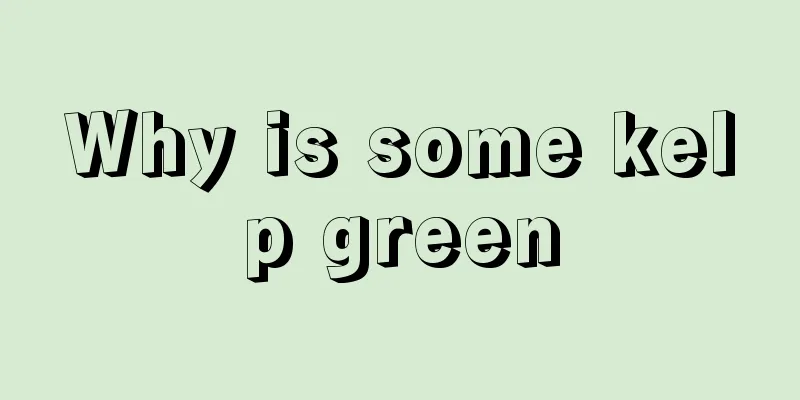Why is some kelp green

|
The general color of kelp is dark green, and green kelp is also normal. This is mainly because kelp contains chlorophyll, so kelp appears green, and the color change of kelp is related to the environment in which it lives. Kelp is a food that contains many minerals and is suitable for us to supplement iodine. However, it is not advisable to eat too much kelp because it can cause thyroid diseases such as hyperthyroidism. Is it normal for kelp to be green? The green kelp variety is quite normal. Kelp is native to Hokkaido, Japan. It did not exist in ancient China. The kelp we eat was introduced from Japan in the 1920s and 1940s. As the planting area expands, China has also begun to gradually try to cultivate excellent kelp varieties, green kelp is one of them. The roots of this kelp are still brown, but the leaves above gradually turn green. In other words, fresh kelp comes in both brown and green colors, and it is not fake. In addition, the color of kelp is also related to factors such as local ocean lighting conditions. Color changes of kelp Kelp belongs to brown algae, which mainly includes two colors of pigments, one is green chlorophyll, and the other is yellow or brown carotenoids, such as β-carotene, phycoxanthin, fucoxanthin, etc. They are mainly stored in chloroplasts, and chlorophyll is also bound to proteins. There is a hole in the center of the chlorophyll molecule, which normally contains a magnesium atom, making the chlorophyll appear green. But under acidic conditions, the magnesium atoms will be driven away by the hydrogen atoms, and the chlorophyll will turn into yellow "pheophytin". After the kelp is taken out of the water, the kelp cells lose their activity, the chlorophyll separates from the protein, and the organic acids in the cells are released, causing the magnesium ions to escape from the chlorophyll molecules, and the kelp turns yellow-brown. Color Restoration of Kelp Fresh kelp is rather troublesome in terms of logistics and storage, so dried kelp is more widely used. However, the dried kelp turns yellowish brown after being soaked, so it needs to be "regreened". A common way is to soak it in zinc chloride or calcium chloride. The principle is actually to find a companion for chlorophyll, such as a calcium atom or a zinc atom. Chlorophyll and these metal atoms form a stable structure, which not only makes it brightly colored, but also has stable chemical properties and is not easy to change color. However, regreening also has disadvantages. For example, it will make the kelp taste hard, because metal ions can combine with the polysaccharides in the kelp and change its gel properties. In addition, some people use copper sulfate or copper chloride to treat kelp. The principle is to form copper chlorophyll, rather than using copper sulfate for dyeing. In fact, it is the same thing as turning rice dumplings green again. Copper chlorophyllin itself is a legal food additive. Decolorization of kelp The kelp that has been regreened will appear dark green or even black after drying, but consumers are not fond of this color, so sometimes it will be bleached after regreening. There are many ways to decolorize. Some use heating to degrade chlorophyll, some use acid and alkali treatment, and some use (food grade) hydrogen peroxide treatment. Among them, hydrogen peroxide treatment is fast, effective, highly safe, and has little impact on taste. The possibility of kelp being dyed It can be said that there are many ways to make kelp green, but it is unlikely to dye it directly with pigments. On the one hand, it is a serious violation of the law and is easy to be held criminally liable; on the other hand, problems such as uneven pigmentation and bleaching due to immersion are easy to detect; What's more, other treatments are cheaper than pigment dyeing. Nutritional value of kelp Kelp contains a variety of minerals and vitamins and has high nutritional value. Among foods, it has the highest iodine content. Kelp can serve as a treasure trove of calcium and iron for humans. The protein and carbohydrates contained in kelp are unmatched by most vegetables and are several to dozens of times that of spinach. It also contains a lot of important vitamins such as carotene, riboflavin, thiamine and niacin. Kelp contains almost no fat but contains a large amount of cellulose, alginate and a variety of trace elements. Basic nutrients Kelp is rich in carbohydrates, but less in protein and fat. Every 100 grams of dried kelp contains 8.2 grams of protein, 0.1 gram of fat, and 56.2 grams of carbohydrates. It can provide about 258 kcal of heat energy to the human body and is a heat food. Dietary fiber Every 100 grams of dried kelp contains 9.8 grams of dietary fiber. Dietary fiber has a unique nutritional function in the human body. It can promote gastrointestinal motility, increase the secretion of digestive juices, reduce the absorption of harmful substances, and integrate cholesterol, reducing the absorption of cholesterol, thus playing a preventive role in hypercholesterolemia and arteriosclerosis. Minerals and trace elements Kelp contains a wide variety of minerals and trace elements. Every 100 grams of dried kelp contains 4.36 grams of potassium, 2.25 grams of calcium, 0.21 grams of phosphorus, 0.15 grams of iron, and 0.34 grams of iodine. It also contains large amounts of trace elements such as strontium, titanium, vanadium, manganese, zinc, cobalt, and copper. Kelp is a type of seaweed that is high in iodine. Cultured kelp generally contains 3% to 5% iodine, and some can reach 7% to 10%. Kelp is the only source of iodine in my country. The iodine used in industry and medicine in my country mainly relies on the kelp industry. Vitamins Kelp is rich in vitamins. Such as vitamin A, vitamin D, vitamin C, VB1. VB2. VB5, VB6, VB12, vitamin E, vitamin K, etc. If the drying process is done properly, the high vitamin content of kelp can be protected from being destroyed. Compared with other seaweeds, kelp has relatively high content of VB1, VB6 and VC. Regular consumption of kelp can supplement the vitamins needed by the human body and prevent and treat vitamin deficiency. Compared with spinach and rapeseed, in addition to containing vitamin C, the content of crude protein, sugar, calcium and iron in kelp is several to dozens of times higher. |
<<: What will happen if I have small Sanyang_What will happen if I have small Sanyang
>>: The difference between thick kelp and thin kelp
Recommend
What are the symptoms of heart damage
Now our living standards are gradually improving,...
Can nasopharyngeal carcinoma be treated biologically? How to take care of it?
There are many treatments for nasopharyngeal carc...
How to regulate the excessive internal heat?
In life, we often get blisters on our lips and pi...
What causes esophageal discomfort?
The esophageal mucosa becomes thicker, which is v...
Why do I feel hot and sweaty?
Some people always have the problem of feeling ho...
Experts introduce the main symptoms of uterine cancer
Compared with other diseases, uterine cancer is v...
How to wear a shawl
With the coming of winter, shawls are a common si...
What to do if pancreatic cancer ascites recurs
As the old saying goes, people who eat whole grai...
What is the best solution for a blocked tear sac?
Many people think that most patients with blocked...
Why does sugar garlic turn green
Sugar garlic is a kind of food pickled with sugar...
Can rabbit plague be transmitted to humans?
Rabbit plague is a highly contagious disease that...
Differential diagnosis method of pituitary tumor
Many people think that if they have a tumor, they...
Is one breast larger than the other a sign of breast cancer?
One breast is larger than the other, which may be...
When is the best time to drink tea?
Tea culture and wine culture are the cultural her...
Can leek and ginger juice enhance sexual function and stop diarrhea?
Chives and ginger are very common ingredients in ...









